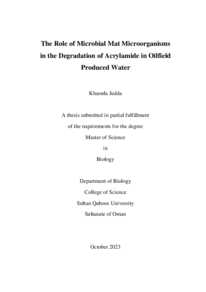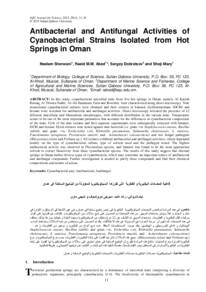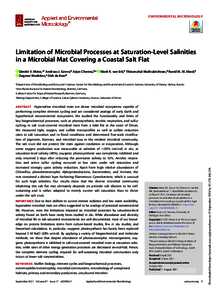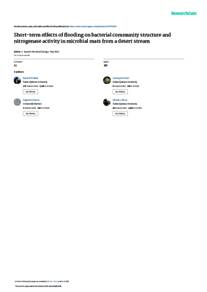Document
The Role of microbial mat microorganisms in the degradation of acrylamide in oilfield produced water.
Source
Master's thesis
Country
Oman
City
Muscat
Publisher
Sultan Qaboos University
Gregorian
2023
Language
English
Thesis Type
Master's thesis
English abstract
Constructed wetlands have been proven effective in treating the significant amounts
of produced water generated from oil extraction operations. However, with the
increasing use of partially hydrolyzed polyacrylamide (HPAM) in enhancing oil
recovery, and its natural degradation into its toxic acrylamide (AM) monomer, the
negative impacts of AM on the biological processes of wetlands have been gaining
increased research attention. Microbial mats in wetlands play a key role in the
bioremediation of hydrocarbons present in produced water, and the effect of this AM
contamination on the mats is still understudied. This project aims to investigate the
impact of AM on microbial mats, and their potential for AM degradation under
aerobic and anaerobic conditions at different AM concentrations, using GC and
HPLC techniques, respectively. Additionally, AM degradation by pure bacterial and
algal strains was explored. Results showed that AM generated CO2 in the mat
treatment groups (500, 1000, and 2000 mg/L AM), indicating that AM was being
used as a carbon source. The mats were also found to degrade AM efficiently within
28 days of incubation under aerobic conditions, while very slow rates were observed
under anaerobic conditions. Aerobic mat incubations at 500 mg/L and 1000 mg/L
AM resulted in 95 ± 0.1% and 90 ± 10.6% AM degradation, respectively. Moreover,
independent growth of bacterial and algal isolates in AM revealed interesting
degradation efficiencies, where some strains have fully degraded AM up to 1000
mg/L after 7 days and 34 days, respectively. It was concluded that wetland microbial
mats adapt well to AM and could maintain their respiration and hydrocarbon
degradation activities in the field
Arabic abstract
أثبتت الاراضي الرطبة المبنية فعاليتها في معالجة كميات كبيرة من المياه الناتجة من عمليات استخراج النفط. ولكن، مع الاستخدام المتزايد للبولي أكريلاميد المتحلل جزئيًا )HPAM )في تعزيز استخلاص النفط، وتحلله الطبيعي إلى مونومر الاكريلاميد )AM )السام، حظيت التأثيرات السلبية للـAM على العمليات البيولوجية للأراضي الرطبة باهتمام بحثي متزايد. تلعب الحصائر الميكروبية في الاراضي الرطبة دورا رئيسيًا في المعالجة الحيوية للهيدروكربونات الموجودة في المياه المنتجة، ولا يزال تأثير تلوث الAM على الحصائر غير مدروس جيدًا. هدف هذا المشروع هو التحقيق في تأثير الAM على الحصائر الميكروبية، وإمكانيتها في تحليل الAMتحت ظروف الهواء الطلق وبدون هواء على تراكيز مختلفة من الAM، بإستخدام تقنيات ال GC وHPLC، على التوالي. بالاضافة إلى ذلك، تم استكشاف تحليل الAM بإستخدام سلالات بكتيرية وطحلبية نقية. أظهرت النتائج أن الAM أنتج ثاني أكسيد الكربون في مجموعات معالجة الحصيرة )،500 ،1000 يغرام في اللتر من الAM)، مشيرة إلى انه تم استخدام الAM كمصدر للكربون. وتبين أيضاً ّ و2000 ِمل يوما من الحضانة في ظل الظروف الهوائية، بينما ً أن الحصائر قادرة على تحليل الAM بكفاءة خلال 28 جدا في ظل الظروف الالهوائية. أظهرت حضانات الحصيرة الهوائية عند 500 ً لوحظت معدالت بطيئة يغرام في اللتر AM إلى تحلل 95 ± %0.1 و90 ± %10.6 AM، على التوالي. وعالوة على ّ و1000 ِمل ذلك، كشف النمو المستقل للعزالت البكتيرية والطحلبية في الAM عن كفاءات تحلل مثيرة للإهتمام، حيث يغرام في اللتر بعد 7 أيام و34 يو ًما، على التوالي. ختم ّ حللت بعض السلالات الAM بالكامل حتى 1000 ِمل المشروع بالتوصل إلى أن الحصائر الميكروبية في المناطق الرطبة تتكيف بشكل جيد مع تلوث الAM، وقادرة على الحفاظ على أنشطتها التنفسية وتحليل الهيدروكربونات في الميدان.
Category
Theses and Dissertations




